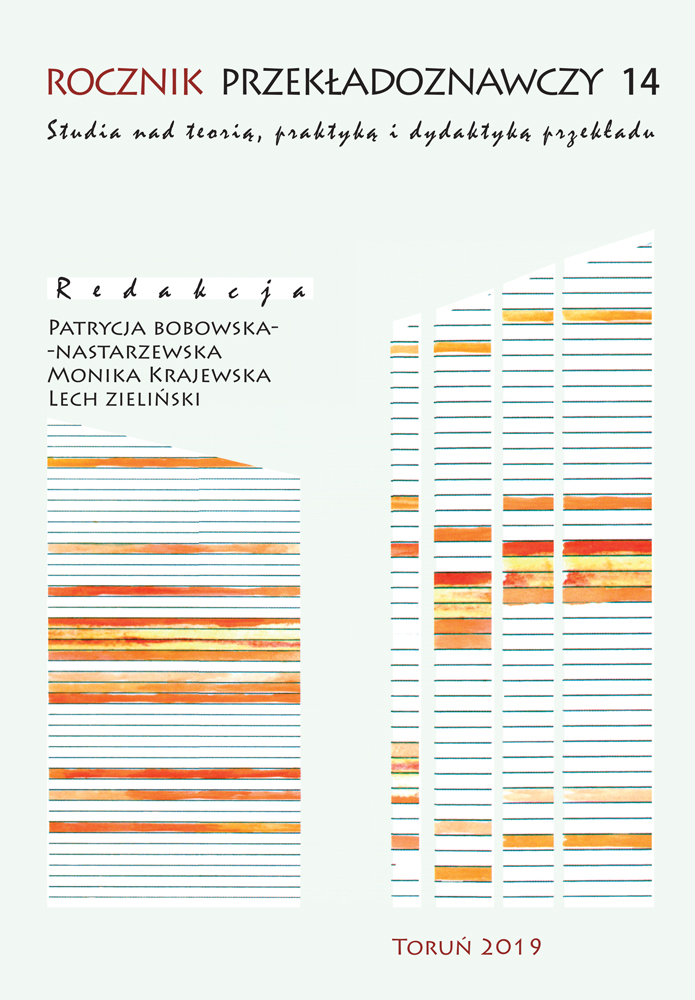Tłumaczenie audiowizualne w wersji lektorskiej – czynniki oceny jakości
DOI:
https://doi.org/10.12775/RP.2019.010Słowa kluczowe
tłumaczenie audiowizualne, wersja lektorska, jakość w tłumaczeniu, standardy jakościAbstrakt
Artykuł ma na celu rozważenie, w jakim stopniu parametry oceny tłumaczenia audiowizualnego dla wersji dubbingowej (Chaume 2007) mogą stanowić punkt wyjścia do oceny jakości tłumaczenia wykonanego na potrzeby wersji lektorskiej, zagadnienia w dużej mierze dotychczas zaniedbanego. Analizie podlegają priorytety takie jak wiarygodne i realistyczne dialogi, spójność pomiędzy słowami a obrazem oraz wierność oryginałowi w zakresie treści, formy, funkcji i zamierzonego efektu. Omówione zostają również czynniki wpływające na jakość tekstu docelowego, będące poza wpływem samego tłumacza, a wynikające z realiów, w jakich pracuje.
Bibliografia
Bartolome A. I. H., Cabrera G. M., 2005, New trends in Audiovisual Translation: The Latest Challenging Modes, University of Valladolid, Valladolid.
Bednarczyk A., 2015, Idiolekt w przekładzie, „Między oryginałem a przekładem”, 29, s. 55–68.
Belczyk A., 2007, Tłumaczenie filmów, Wilkowice.
Bogucki Ł., 2004, Relewancja jako ograniczenie w procesie tworzenia napisow, „Journal of Specialised Translation”, Issue 01, http://www.jostrans. org/issue01/ issue01toc.htm (dostęp: 28.04.2019).
Bogucki Ł., 2010, The Demise of Voice-over? Audiovisual Translation in Poland in the 21st Century, „Meaning in Translation”, Łódź, DOI: https:// doi.org/10.3726/978-3-653-00940-8.
Chaume F., 2004, Cine y traduccion, Madrid.
Chaume F., 2007, Quality standards in dubbing: a proposal, „Tradterm”, 13, s. 71–89, https://doi.org/10.11606/issn.2317-9511.tradterm.2007.4746.
Chaume F., 2013, Research Paths in Audiovisual Translation: The Case of Dubbing, [w:] Routledge Handbook of Translation Studies, F. Bartrina, C. Millan-Varela (red.), London, s. 288–302.
Diaz-Cintas J., Orero P., 2006, Voice-over, [w:] Encyclopedia of Language and Linguistics, K. Brown (red.), Oxford, s. 477–479.
Diaz-Cintas J., Remael A., 2014, Audiovisual Translation: Subtitling, New York.
Espasa E., 2004, Myths about documentary translation, [w:] Topics on audiovisual translation, P. Orero (red.), Amsterdam–Philadelphia, s. 183–197.
Franco E., 2000, Documentary film translation. A specific practice?, [w:] Translation in context, A. Chesterman, N. Gallardo, Y. Gambier (red.), Amsterdam–Philadelphia, s. 233–242.
Franco E., Matamala A., Orero P., 2010 Voice-over Translation. An Overview, Bern.
Garcarz M., 2007, Przekład slangu w filmie. Telewizyjne przekłady filmów amerykańskich na język polski, Kraków.
Garcarz M., Widawski M., 2009, Przełamując bariery tłumaczenia audiowizualnego. O tłumaczu telewizyjnym jako twórcy i tworzywie, „Przekładaniec”, 20, s. 40–49.
Gottlieb H., 1997, Subtitles, Translation & Idioms, University of Copenhagen, Kobenhavn.
Gouadec D., 2007, Translation as Profession, Amsterdam–Filadelfia.
Hasior A., 2018, Documentary translation in the Polish market of television programmes, [w:] Języki specjalistyczne w lingwistyce stosowanej: między teorią a praktyką, M. Aleksandrzak (red.), Poznań, s. 63–77.
Hasior A., 2019, .Te vistes de corto o de largo? Algunas consideraciones acerca de la traduccion de elementos culturales y lenguaje arcaico en la traduccion audiovisual, [w:] Las lenguas ibericas en la traduccion y la interpretacion, K. Popek-Bernat et al. (red.), Warszawa, w druku.
Hurtado Albir A., 2007, Traduccion y Traductologia. Introduccion a la Traductologia, Madrid.
Jankowska A., 2012, Kompetencje tłumacza audiowizualnego, [w:] Kompetencje tłumacza, M. Piotrowska et al. (red.), Kraków, s. 243–265.
Lipiński K., 2006, Vademecum tłumacza, Kraków.
Luyken G. M., 1991, Overcoming Language Barriers in Television. Dubbing and Subtitling for the European Audience, Manchester.
Matamala A., 2009a, Translating documentaries: from Neanderthals to the Supernanny, „Perspectives Studies in Translation Theory and Practice”, 17(2), s. 93–107. DOI: 10.1080/09076760902940112.
Matamala A., 2009b, Main challenges of documentary translation, [w:] New Trends in Audiovisual Translation. Topics in Translation, J. Diaz Cintas (red.), Bristol–Buffalo–Toronto, s. 109–119.
Matkivska N., 2014, Audiovisual Translation: Conception, Types, Characters’ Speech and Translation Strategies Applied, „Studies About Languages”, 25. DOI: https://doi.org/10.5755/j01.sal.0.25.8516 (dostęp: 31.07.2019).
Mayoral R., Kelly D., Gallardo N., 1988, Concept of Constrained Translation. Non-Linguistic Perspectives of Translation, Meta 33(3), s. 356–367. DOI: 10.7202/003608ar.
Orero P., 2004, The pretended easiness of voice-over translation of TV interviews, „Jostrans”, 2, s. 76–96, http://www.jostrans.org/issue02/art_orero. php (dostęp: 31.03.2019).
Orero P., 2006, Synchronization in voice-over, [w:] A new spectrum of Translation Studies, J. M. Bravo Gonzalo (red.), Valladolid, s. 255–264.
Sepielak K., Matamala M., 2014, Synchrony in the Voice-over of Polish Fiction Genres, „Babel”, 60(2), 145–163. DOI: 10.1075/babel.60.2.02sep.
Szarkowska A., 2009, The Audiovisual Landscape in Poland at the Dawn of the 21st Century, [w:] Foreign language movies – Dubbing vs. Subtitling, A. Goldstein, B. Golubowić (red.), Hamburg, s. 185–201.
Tomaszkiewicz T., 2008, Przekład audiowizualny, Warszawa.
Woźniak M., 2009, Jak rozmawiać z kosmitami? Kilka uwag o tłumaczeniu lektorskim telewizyjnych filmów fantastyczno-naukowych (na przykładzie „Star Trek”), „Przekładaniec”, 20, s. 50–88.
Woźniak M., 2012, Voice-over or Voice-in-between? Some Considerations about the Voice-over Translation of Feature Films on Polish Television, [w:] Audiovisual Translation and Media Accessibility at the Crossroads. Media for All 3, A. Remael, P. Orero, M. Carroll (red.), Amsterdam–New York, s. 209–228.
Pobrania
Opublikowane
Numer
Dział
Statystyki
Liczba wyświetleń i pobrań: 1027
Liczba cytowań: 0



